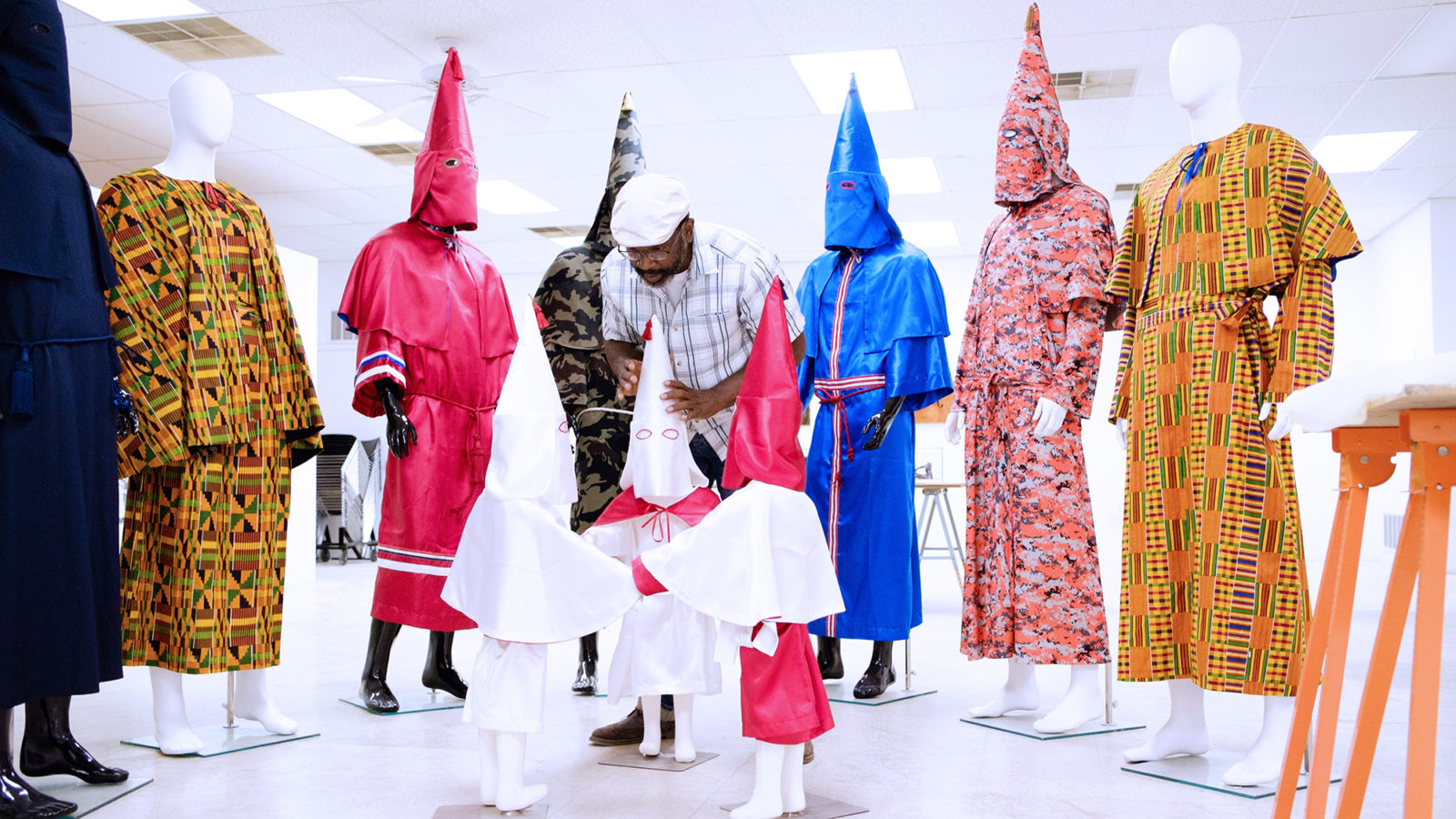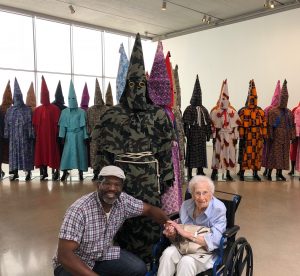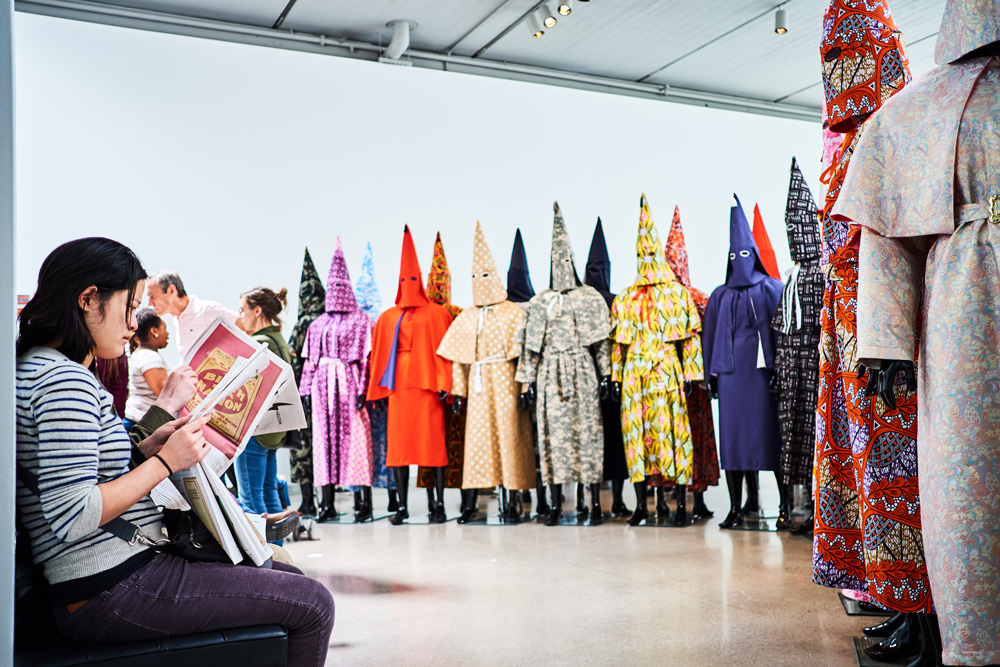Paul Rucker Calls Attention to the Normalization of Systemic Racism Through His Art Practice

Paul Rucker is an artist full of historical facts about racism against black people in the United States of America. In the inaugural exhibition at the Institute for Contemporary Art at VCU in Richmond, he displays historical artifacts related to slavery and white supremacy, including pro-slavery books, Ku Klux Klan paraphernalia, and lynching postcards from the early 20th century. When Rucker wanted to add a Ku Klux Klan robe to his collection, he was unable to find one—likely a result of the country’s effort to erase its violent and racist past. In response, Rucker began making his own robes. Adapted from the design of a KKK robe from 1920, Rucker’s robes are sewn out of a myriad of fabrics, including multicolored Kente cloth, camouflage, and spandex. His goal is to ensure this period of history is not forgotten and to connect this iconic costume to the present. He discussed this work in a TED Talk earlier this year, and his robes are on display in a group exhibition ICA at VCU through September 9, 2018. All of this is part of his Creative Capital project, Rewind, an ongoing project connecting the history of racism in the US to contemporary problems like mass incarceration, disparities in wealth, and inequality in education.
We spoke to Paul Rucker during the premiere of his work.
Alex Teplitzky: Can you tell me about the exhibition?
Paul Rucker: I’m part of the inaugural show entitled “Declaration” at the Institute for Contemporary Art in Richmond. I’m one of 40 artists there, but my part of the show has the largest footprint. If you walk into the first floor gallery, you’ll see 52 mannequins arranged in an “X” wearing multi-colored Ku Klux Klan robes that I made. They’re in different colors, pink, green, and fabrics ranging from Kente cloth to spandex, meant to show the changing form of systemic and structural racism.
Around the robes there are three vitrines that display artifacts from the early 20th century, during the second wave of the Ku Klux Klan. These include an original poster of Birth of a Nation and program, Thomas Dixon’s book from 1905 called the Klansman, and the playbill from the 1906 play The Klansman. In the second case, there are items from the organization, such as KKK membership cards, manuals, newspaper articles, their constitution for the men’s and women’s auxiliary. The Klan had 5 million active members in the 1920s, and the women’s auxiliary had a half million people. With all those members, the factory in the Buckhead neighborhood of Atlanta where the Klan robes were manufactured had to operate 24 hours a day to keep up with demand. There were 20,000 robes on hand to keep up with orders.
The Klan at that time was a huge organization. My overall work in the show talks about how the policies the Klan were pushing forward at the time are still affecting us today. It’s through the normalization of systemic racism that we have segregated schools, neighborhoods and workplaces today. These things are normal even though they should not be.
People have mentioned how startling and provocative my work is, but the truth is, there’s nothing more shocking than things happening outside the doors of the gallery. What’s happening in our streets is far more shocking.
Alex: Talk more about how the history affects people in the US today.
Paul: Well, if you take a “chocolate city” like where I am right now in Richmond, or in Baltimore, you can go to any company and see that the people working there don’t represent the demographics of the city. If a city is 50% black, but a company in that city is mostly white except for the custodial staff, that’s a problem. If you go to Church Hill in Richmond, or any of the gentrified communities, and you have 95% white population in a city where those neighborhoods used to be black communities, that’s a problem.
Schools in Richmond are being affected by mold problems. Schools in Baltimore had to close down because they don’t have adequate heating systems. This is in 2018 that this is happening.
Alex: So your work calls attention to historical racism to show how it affects the country today?
Paul: Yes, but the Ku Klux Klan is weak today. Compared to the 1920s, they only have 5,000 members in about 150 chapters. The people enforcing white supremacy today are normal, everyday people, who are not associated with any groups whatsoever. When you have a structure in place in which a black female with an Associate’s Degree is less likely to get a job than a white female who dropped out of high school, we have a problem.
I think we should talk about racism in the same way that we talk about trees. We talk about trees in nuanced categories like spruce, pine, maple—all the different varieties. When we talk about racism, we should talk about systemic racism, structural racism, medical racism, environmental racism.
Look at Flint, Michigan, for instance, where the situation there is still not resolved. If it happened in San Francisco, they would already have new pipes and a clean drinking system. We need to look at different systems, at who’s being taken care of and who’s not being taken care of, and why.
Alex: Can you talk about the educational gaps about systemic racism?
Paul: There’s a lot of false narratives that we’re dealing with. Actually, the second display case in my part of the exhibition deals with how organized the Klan was. There were over 90 newspapers put out by the organization in the 1920s. The third vitrine addresses white supremacy ideology: black people being less than human, intellectually inferior, lazy, or sexually voracious. The idea that black men crave white women was depicted in Birth of a Nation in 1915, and that false narrative continues to be pervasive in our society today.
I have pro-slavery books from the era, one called The Negro: A Beast, that talks about black people being a product of a white woman being raped by a beast. In another book, White Supremacy and Negro Subordination, the author argues that black people were put on earth to be slaves. I have a book called The Negro at Home that talks about how black people can’t survive on their own. It says they would die like cattle if they weren’t slaves being taken care of. There are even more modern books, like The Bell Curve, that talk about black inferiority using false science. What keeps this problem going are the disparities that exist in education and education access, implicit bias in our schools in how students are treated, high disciplinary rates, zero tolerance disproportionately leveled against black students.
Many people don’t know the true history of America—and that’s not by accident. There’s this false narrative that successful people have what they have because they’re smarter or worked harder, not because they’re part of a different system.
I have lynching postcards on display in the show, which is pretty emotional and disturbing. Interestingly, I went to see BlacKkKlansman the other day, and in one scene Harry Belafonte describes this lynching. One of the postcards in the show is that same lynching of Jesse Washington. It hit me hard because I’ve studied this lynching so much.
It’s great that people are talking about lynching, and talking about this really significant part of our history. I went to see Bryan Stevenson’s National Memorial for Peace and Justice that acknowledges the 4,300 documented lynchings that happened across the country —that Memorial is still with me. The violence towards black people continues today, not just in terms of police violence, but also in economic violence. Some people will probably think, “well if they just got an education, they would be OK.” I’m really trying to address these kinds of false narratives of people who think society is hurting because it’s their own fault. There’s an opportunity to use art to do that with art.
Alex: I think about the Truth and Reconciliation Commission in South Africa and other initiatives to examine crimes against humanity. The US never took a hard look at what happened before, during, and after slavery, and the Civil Rights-era, like South Africa did. Your work might be considered troubling by some—it was even censored at one point—but at the same time it’s so necessary to acknowledge the truth, isn’t it?
Paul: People have mentioned how startling and provocative my work is, but the truth is, far more shocking things are happening outside the gallery. What’s happening in our streets is far more shocking. I’ve considered placing a sign at the exit of the museum stating, “Things you may see beyond these doors, you may find disturbing.”
We’ve witnessed many people die in front of us: Walter Scott shot in the back five times, Eric Garner choked to death, Philando Castile, Sandra Bland, Tamir Rice, Laquan McDonald. We’ve become desensitized to black death, and that concerns me. My goal is not to desensitize, but to create awareness around the parallels between our country a hundred years ago and our country today.
I don’t think art was ever meant to be easy. One thing I want to do is make the next generation after me a little bit safer by creating empathy. I want people to see how they’re complicit in what’s happening today.
Alex: Have there been any major realizations while creating or presenting this new work?
Paul: I realized that it’s not the KKK that poses the greatest threat to the well-being of black Americans, or even the “alt-right.” The biggest realization is that white supremacy will continue in this country as long as white progressives fail to acknowledge their privilege and participate in the inequities under which they benefit.

Paul Rucker and Lucy Oliver, 103 years old, at ICA VCU in Richmond.
Alex: Your work is such a powerful platform for conversation about these issues. Can you tell me about some examples of those?
Paul: I just had a beautiful meeting a couple of days ago with a lady who came to see the show. She was in a wheelchair and I found out she’s 103 years old. I took her around the show to each individual case and gave her a tour of the exhibition. She was born in 1915, the same year that Birth of a Nation came out. It’s amazing to have someone who was born in the same time period I am focusing on. She was born before women had the right to vote, and before the end of World War I.
Alex: Wow, so what did she think?
Paul: She enjoyed it. We had a great conversation. To be able to talk about history with someone who actually lived it is incredible.
Alex: I want to mention that you’re most known as a cellist, but here we are talking about your sculpture and archival work. You also make hot sauce, and we have a sample in the refrigerator in our office! How do you manage to work in all these disciplines?
Paul: I barely do, actually. I’m burned out all the time, but I have the most pleasant burn out you can imagine. I love doing.
The food sauce project is going to launch fully next year. I’m going to hire formerly incarcerated folks. I want to build a company that’s going to be self-sustaining, and and that will provide jobs to people and youth who have been formerly incarcerated. There are different ways for artists to address social justice, it’s great to bring awareness about an issue, but I think we need to spend some time on the ground providing services, like jobs and opportunities that address disparities.
The struggle is not for sale. I believe it’s irresponsible to make money on a struggle you’re not also addressing outside of art making. When I sell a piece that deals with the Alabama Church bombing, or other instances of black death, I don’t put that money in my pocket, it goes back into creating more work, or to communities that need support bringing the show to them. We need people now who are willing to be a part of the struggle, and willing to sacrifice their lives, literally and metaphorically, to make change happen.
It’s important to speak the truth and make the unseen seen in order to create some kind of empathy, so that we can move forward.

A visitor to the museum reads Paul Rucker’s publication for the exhibition.
Alex: How was Creative Capital helpful in this project?
Paul: Creative Capital allowed me to think big and take chances. I received the Award in 2012, when my project was a lot smaller. Things I have learned through the Retreat, and Strategic Planning sessions with Colleen Keegan, still ring true to me today. As an artist, you can often feel like an imposter in your success. We have to address this poor artist mentality. Since receiving the Creative Capital Award, I have received support from Joan Mitchell, Rauschenberg, Guggenheim, MAP Fund. The list is long, but I still have an imposter complex, which makes me feel inadequate and not deserving. Creative Capital has helped me feel more gracious, in some ways more confident in accepting these accolades and awards.
Creative Capital takes artists’ careers and skyrockets them. It continues to skyrocket my career. I receive good news on a regular basis.
The money is a small part of what Creative Capital offers. The biggest part is resources. When you’re younger you think all you need is money. Later you realize resources and connections are where it’s at. During the 2012 retreat I met Jane Brown and Neil Didriksen of the Robert W. Deutsch Foundation from Baltimore, Maryland. Since 2012 they have provided me with support and resources for my projects. I became the Robert W. Deutsch Foundation Artist in Residence and Research Fellow at the Maryland Institute College of Art for two years, and that allowed me to focus on the majority of the work for this Creative Capital premiere.
Paul Rucker’s work premiered at the inaugural exhibition at the Institute for Contemporary Art at Virginia Commonwealth University in Richmond, Virginia. Rucker is an iCubed Arts Research Fellow at Virginia Commonwealth University in Richmond, Virginia.
